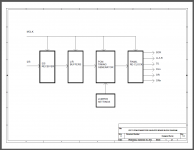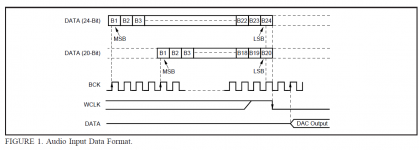hmm I guess I havent had as many troubles, as I see it the PC has more than enough processing power, is more flexible and allows the crossover, volume control and OSF to be part of one and the same process. hardware is nice and I understand what you mean, but the issues you speak of are with certain software designers and the users susceptibility to black magic claims, nothing to do with the PC/MAC itself.
write the code to utilize the vector processor in the i5/7 or a suitable graphics card
The concern people still have with any PC is still the operating system, too many different types of hardware combinations to ensure 100% data integrity 100% of the time. But I agree that it should be a non-issue, if you do simple checks. However spitting out a real-time 384khz i2s stream from a home computer isn't really something folks have validated.
Well, you can do it both ways:
Oversample and play it "on the fly" or oversample and store it as an (say) 24/192 file.
Needs more disk space though...
This way, you can play the already oversampled files without the PC on, just a NAS and a network player with S/PDIF 192kHz out. There are some around now AFAIK.
Oversample and play it "on the fly" or oversample and store it as an (say) 24/192 file.
Needs more disk space though...
This way, you can play the already oversampled files without the PC on, just a NAS and a network player with S/PDIF 192kHz out. There are some around now AFAIK.
Maybe it should be highlighted that this board will also deliver the inverted data.
Especially for AD1865 as a stereo DAC, you can use one per channel.
As one channel is inverted, some currents will cancel out (eg Iout R = -Iout L), this can lead to improved performance, less modulation on the supplies and less ground bounce etc.
I like this feature as I want to have an all balanced setup from DAC to power amp.
Especially for AD1865 as a stereo DAC, you can use one per channel.
As one channel is inverted, some currents will cancel out (eg Iout R = -Iout L), this can lead to improved performance, less modulation on the supplies and less ground bounce etc.
I like this feature as I want to have an all balanced setup from DAC to power amp.
I wanted to point this out...Well, you can do it both ways:
Oversample and play it "on the fly" or oversample and store it as an (say) 24/192 file.
Needs more disk space though...

I'm planning the same, converting and saving in batch my whole library to (let's say) 24/192 and play through and SB Touch from an USB 1T hard-drive. Hard-drive space is cheap, no need to trouble with fast processing to have on the fly conversion.
Hi qusp, you are right on this. I'm relatively 'new' here and would not like to sound as advertising anything, however there is software player which I consider ultimate achievement in digital audio reproduction.4 x isnt enough IMO
It's called XXHighEnd and it's author implemented up to 16 times 'upsampling' - depending on DAC capabilities. 'Upsampling' is actually proprietary algorithm. Another achievement is software filtering iof hardware filtering. Simply, amazing piece of code. It requires capable PC, more cores/threads - faster processing. And it's memory player - the only way to go PC audio.
George
It's called XXHighEnd and it's author implemented up to 16 times 'upsampling' - depending on DAC capabilities.
Doesn't that design (Phasure) use PCM1704? The datasheets from TI/BB show that DAC performs worse at 16X than the PCM63 (earlier generation) does at 8X OS. What advantage do you see in going to 16X?
Exactly, PCM1704U/K and 8 of them (4 per channel). Don't know about datasheet(s) but have a look @ graphs (first generation NOS1 DAC, sampling rate limited by interface PC-DAC used)Doesn't that design (Phasure) use PCM1704? The datasheets from TI/BB show that DAC performs worse at 16X than the PCM63 (earlier generation) does at 8X OS. What advantage do you see in going to 16X?
As SW user for several years now (moving from cic's cMP) all I can say: re-creation of 3D stage, recording ambient and for example sound of cymbals, hi-hat's etc. (I'm not musician, just listener 🙂) it's like live performance. I use (or re-discover) almost strictly 16/44.1 material. Older CD's preferably, "pre-loudness-war" 🙂
IMO it depends as well on the analog LPF that follows.4 x isnt enough IMO
What kind of LPF are you using/would you use at 8x?
Last edited:
Exactly, PCM1704U/K and 8 of them (4 per channel). Don't know about datasheet(s) but have a look @ graphs (first generation NOS1 DAC, sampling rate limited by interface PC-DAC used)
As SW user for several years now (moving from cic's cMP) all I can say: re-creation of 3D stage, recording ambient and for example sound of cymbals, hi-hat's etc. (I'm not musician, just listener 🙂) it's like live performance. I use (or re-discover) almost strictly 16/44.1 material. Older CD's preferably, "pre-loudness-war" 🙂
Yep, anyway you look at it, there is potential here for better things, a new direction for home audio, more potential than relying on propretary code or lone-wolf code burned to FPGA's.
Yep, anyway you look at it, there is potential here for better things, a new direction for home audio, more potential than relying on propretary code or lone-wolf code burned to FPGA's.
Agree,
Ian
Revised block diagram
Sorry, forgot put the DLn, DRn on the block diagram. Actually they were shown on the PCB silkscreen. Good eye! Here is the revised block diagram.
Inside my FPGA/CPLD design, DLn and DRn are not simply inverted by NOT buffers. They were synchronized by MCLK with the same raising edge. So, there is no delay between DL and DLn, as well as DR and DRn.
Yes, this feature is useful for configuring NOS DACs working at differential mode. It's very easy to setup two or four DACs into dual mono mode with those signals.
Ian
Sorry, forgot put the DLn, DRn on the block diagram. Actually they were shown on the PCB silkscreen. Good eye! Here is the revised block diagram.
Inside my FPGA/CPLD design, DLn and DRn are not simply inverted by NOT buffers. They were synchronized by MCLK with the same raising edge. So, there is no delay between DL and DLn, as well as DR and DRn.
Yes, this feature is useful for configuring NOS DACs working at differential mode. It's very easy to setup two or four DACs into dual mono mode with those signals.
Ian
Attachments
Testing result of PCM1704 timing from logic analyzer
To get perfect timing for PCM1704, after 24 bit DL and DR shifted into left and right PCM1704, LLLR will go low, CLK will be continued for two additional times before stopped. This is because the special timing requirement of PCM1704. Please see the datasheet of PCM1704 for details. I also attached the waveform from the datasheet. Please correct me if there is anything wrong.
All of the signals will keep low for rest of time to reduce the noise. Please see the waveform from my logic analyzer.
Jumper settings:
J24bit: shorted
JTAIL: shorted
Rest jumpers: keep open
To get perfect timing for PCM1704, after 24 bit DL and DR shifted into left and right PCM1704, LLLR will go low, CLK will be continued for two additional times before stopped. This is because the special timing requirement of PCM1704. Please see the datasheet of PCM1704 for details. I also attached the waveform from the datasheet. Please correct me if there is anything wrong.
All of the signals will keep low for rest of time to reduce the noise. Please see the waveform from my logic analyzer.
Jumper settings:
J24bit: shorted
JTAIL: shorted
Rest jumpers: keep open
Attachments
Hi Vzs, Hi zinsula
Thank you so much for accepting my invitation to evaluate the daughter board. Shipped today. You should receive them in ten days. I’m looking forward to your good news, as well as fixing the bugsJ.
Ian
Thank you so much for accepting my invitation to evaluate the daughter board. Shipped today. You should receive them in ten days. I’m looking forward to your good news, as well as fixing the bugsJ.
Ian
Count me for 4 pcs.
Thanks andrea_mori, it seems NOS fans are much less than DS 🙂.
I'm not sure if there is enough requirements to support a factory SMT run. But at lease I can consider supplying un-assembled mini KIT.
Two gentlemen gonna make some evaluation on the daughter board. Will make decesion after that.
Good luck.
Ian
- Home
- Source & Line
- Digital Line Level
- Drive NOS AD1865/62,PCM1704/02/63,TDA1541 from FIFO: Universal I2S-PCM driver board



